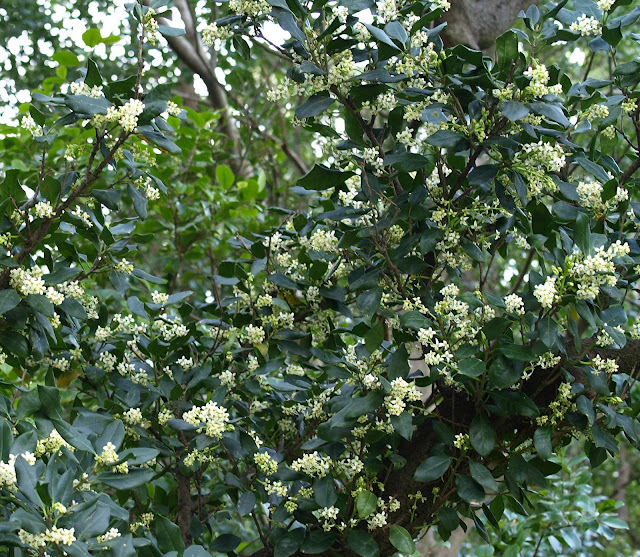White wood and white windmills from Macaronesia
Highly respected Canberra garden writer and designer, Cedric Bryant, wrote to me about Picconia excelsa after a talk I gave at the National Library of Australia on the shared histories and destinies of Sydney and Melbourne's botanic gardens (neutral territory for that kind of discursion). I also spoke afterwards with another audience member about how difficult the species was to propagate.
There was a pleasing symmetry to these conversations and to my prestalk about two of Australia's premier botanic gardens. About nine years ago, while head of the other one (Sydney), I received correspondence about the same plant, which I blogged about soon after.
Mr Bryant wrote about Picconia excelsa in the July 2017 National Trust Magazine (reprinted from the May-July 2017 Bulletin of the Horticultural Society of Canberra), in an article headed 'The Rarest of Trees'. That is true in the sense of having been Red Listed, although it is no longer included in current Red Lists of threatened species in Spain.
As outlined Bryant's article, the Canary Island Laurel, is a member of the olive family from the Canary Islands. And also Madeira. Another species in this genus, Picconia azorica, only grows in the Azores. So one species in Spain and Portugal, the other only in Portugal, but neither growing on the Iberian Peninsula. A good quiz question in there.
It's at least an uncommon species in nature, and rare in cultivation.
Bryant documents specimens growing at Cooma Cottage in Yass (NSW, at Hamilton Hume's Cottage, as I reported in my earlier post), an historic home in Caulfield (Victoria; now part of Melbourne Grammar Junior School) and Geelong Botanic Gardens (Victoria).
There is also at least one fine specimen at Camden Park, in NSW (as Mark Richardson told me back in 2010), and two in the Sydney Royal Botanic Garden. In the UK, says Bryant, there are 16, planted mostly (or all?) between 1914 and 1994.
There is also at least one fine specimen at Camden Park, in NSW (as Mark Richardson told me back in 2010), and two in the Sydney Royal Botanic Garden. In the UK, says Bryant, there are 16, planted mostly (or all?) between 1914 and 1994.
There are three massive specimens in Melbourne Gardens, which must date back a century or so, presumably to the time of William Guilfoyle (1873-1909). Roger Spencer doesn't include this genus in his Horticultural Flora of South-eastern Australia, in hard copy or, at HortFlora, online.
The bark is light in colour, leading to common names of Palo Blanco (in Spain) and White Wood. It is also very rough and fissured.
The white petals of the flowers have been described as like the blades of a windmill, which is a reasonable analogy. They emerge in clusters (rather difficult to get entirely in the field of view, as you can see) from a distinctive row of buds between the opposite leaves. The flowers above are from late August, the buds below from mid-July.
In nature there are trees with only male flowers, and trees with only bisexual flowers (hermaphroditic, with fully functioning male and female parts). Male flowers still have a green bottle-like structure in the middle of the flower but they don't bear a receptive tip - instead, they have a brown fuzzy top as above.
All our trees bear only male flowers, and (almost*) no fruit: the fruit, if it were there, would look very much like an olive. Curiously, one tree, above the toilet block near A Gate, started flowering about a month later than the other two (late September rather than late August) and the flowers were about twice as big (in all dimensions); the leaves also seem to be larger. (We have good sewerage systems in place so I don't expect this has anything to do with the nearby amenities.)
In nature there are trees with only male flowers, and trees with only bisexual flowers (hermaphroditic, with fully functioning male and female parts). Male flowers still have a green bottle-like structure in the middle of the flower but they don't bear a receptive tip - instead, they have a brown fuzzy top as above.
All our trees bear only male flowers, and (almost*) no fruit: the fruit, if it were there, would look very much like an olive. Curiously, one tree, above the toilet block near A Gate, started flowering about a month later than the other two (late September rather than late August) and the flowers were about twice as big (in all dimensions); the leaves also seem to be larger. (We have good sewerage systems in place so I don't expect this has anything to do with the nearby amenities.)
It is said that James Cook, who passed through Macaronesia on his way to the Pacific, 250 years ago, was impressed by the 'verdure of the majestic crown' of this tree. Verdure is a word used regularly by Cook, and Joseph Banks, in their journals. I didn't this particular reference the tree does have a lush, green allure.
In flower it is also rather striking.
In flower it is also rather striking.
Postscript (22 March 2021): Stuart Read, while in Melbourne for the Australian Landscape Conference in March 2021, sees and photographs a single fruit on our specimen above The Terrace cafe. Here is his photo...







Comments